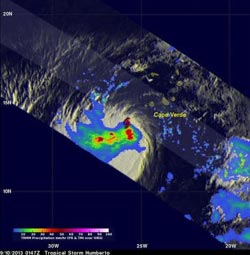NASA sees heavy rainfall in strengthening Tropical Storm Humberto

NASA's TRMM satellite showed a large area of heavy rain (red) south of Humberto's center of circulation on Sept. 9 at 9:47 p.m. EDT. A red tropical storm symbol shows Humberto's approximate center.<br><br>Credit: SSAI/NASA, Hal Pierce<br>
NASA's Tropical Rainfall Measuring Mission satellite called TRMM passed near Humberto on September 10, 2013 at 0147 UTC (9:47 p.m. Sept. 9) and collected data used in this rainfall analysis. TRMM's Microwave Imager (TMI) and Precipitation Radar (PR) showed a large area of heavy rain south of Humberto's center of circulation. Rain was falling at a rate of 2 inches/50 mm per hour.
At 11 a.m. EDT on Sept. 10, Humberto's maximum sustained winds were near 65 mph/100 kph, just 9 mph shy of hurricane-force. Humberto is now predicted by the National Hurricane Center (NHC) to become a hurricane later today, Sept. 10.
The center of Tropical Storm Humberto was located near latitude 14.6 north and longitude 27.7 west, about 220 miles/355 km west of the southernmost Cape Verde Islands. Humberto is moving toward the west-northwest near 9 mph/15 kph and is expected to turn to the northwest later today then north. The estimated minimum central pressure is 998 millibars.
If Humberto becomes a hurricane, it would be the first of the Atlantic Ocean season.
Media Contact
More Information:
http://www.nasa.govAll latest news from the category: Earth Sciences
Earth Sciences (also referred to as Geosciences), which deals with basic issues surrounding our planet, plays a vital role in the area of energy and raw materials supply.
Earth Sciences comprises subjects such as geology, geography, geological informatics, paleontology, mineralogy, petrography, crystallography, geophysics, geodesy, glaciology, cartography, photogrammetry, meteorology and seismology, early-warning systems, earthquake research and polar research.
Newest articles

High-energy-density aqueous battery based on halogen multi-electron transfer
Traditional non-aqueous lithium-ion batteries have a high energy density, but their safety is compromised due to the flammable organic electrolytes they utilize. Aqueous batteries use water as the solvent for…

First-ever combined heart pump and pig kidney transplant
…gives new hope to patient with terminal illness. Surgeons at NYU Langone Health performed the first-ever combined mechanical heart pump and gene-edited pig kidney transplant surgery in a 54-year-old woman…

Biophysics: Testing how well biomarkers work
LMU researchers have developed a method to determine how reliably target proteins can be labeled using super-resolution fluorescence microscopy. Modern microscopy techniques make it possible to examine the inner workings…





















